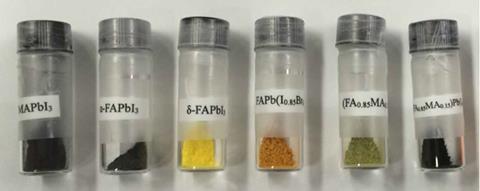Changing most of the hybrid material’s organic component delivers efficiency record in small-scale devices

South Korean researchers have revealed the chemical secrets that have helped them power the ongoing surge in perovskite solar cell efficiency. Sang Il Seok from the Korea Research Institute of Chemical Technology (KRICT) and his team combined the most widely-used methylammonium lead halide perovskite materials with formamidinium lead iodide. This material helped to make a solar cell that absorbs more solar energy, delivering the record 17.9% efficiency level officially recognised by the US National Renewable Energy Laboratory (NREL) last May.
This is already competitive with commercial silicon solar cells, but in November 2014 NREL confirmed that Seok’s team had gone further still, reaching 20.1% efficiency. Though the chemists are yet to publish full details, Seok tells Chemistry World that the cell uses the same material combination, but with a new fabrication process.
Originally the name of a calcium titanate mineral, perovskite now more commonly refers to the material class that shares its AMX3 crystal structure. Photovoltaic perovskites are hybrid organic–inorganic materials, with methylammonium ions usually in the A position, lead or tin as metal ion M and halogen ions as the X component. Work on perovskites has progressed rapidly since cells with an efficiency of 3.8% were first reported in 2009. That’s because their electronic structure is well suited to light absorption, they conduct the subsequently mobilised electrical charges well and are simple to work with, easily crystallising from solution.
The perovskite usually serves as just one level in a multilayer sandwich stack, with other materials helping the photovoltaic current into the electrical circuit the cell’s connected to. Seok’s team had previously developed an especially efficient sandwich, with an extra layer mixing transparent, electron-transporting mesoporous titania electrodes into their methylammonium perovskite material.
Formidable formamidinium
Other researchers had previously swapped methylammonium for formamidinium ions, which gave perovskites with electronic structures that absorb a greater proportion of the light hitting them. However, when exposed to ambient temperature and moisture the formamidinium perovskites reorganised into an unwanted non-perovskite structure. To avoid this problem, the KRICT team incorporated increasing amounts of methylammonium lead bromide into formamidinium lead iodide cells, exploiting their efficient design. At 15% methylammonium lead bromide, efficiency peaked at around 18% while the perovskite phase also stayed stable.
Martin Green from the University of New South Wales in Sydney, Australia calls this efficiency record ‘a notable step’, but stresses that the design is not ready for widespread use. ‘The cells are tiny, less than 0.1cm2, over 2000 times smaller than a normal commercial silicon cell and, perhaps significantly, there is no discussion of moisture or UV tolerance.’
That concern is potentially significant because perovskites are generally water soluble, and degradation caused by moisture in the air could prevent their widespread use in electricity generation. Seok acknowledges this concern, and says that their stabilised formamidinium-based perovskite is hardier under ambient conditions than exclusively methylammonium-based varieties. The KRICT cell design also reduces the extent of hysteresis, another problem common in perovskites that could cause their efficiency to fall on initial exposure to sunlight. Consequently, while Seok says his team is still seeking further physical insights into perovskites, they are also now working on basic technology for commercialisation.
Annamaria Petrozza from the Italian Institute of Technology in Milan underlines that these latest improvements result from the large-scale perovskite crystal structure. ‘The presence of various types of chemical interactions and structural disorder play an important role,’ she says. ‘This is the beauty and the challenge perovskites have presented so far. Sang II Seok and his team show the importance of controlling the structural–compositional properties and that the panorama of possible strategies to further improve device performance, stability and processability is still very wide.’












No comments yet